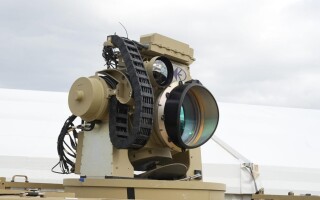AFRL Commander’s Challenge tasks competitors to counter high-altitude aerial threats
StoryOctober 10, 2024

The Air Force Research Laboratory (AFRL) reports that two teams have been chosen to compete in the 2024 AFRL Commander’s Challenge, which seeks solutions to the threats to troops posed by slow-moving, high-altitude, aerial adversaries.
The challenge – open to junior officers, enlisted military members, and U.S. Department of Defense (DoD) civilians from across Air Force Materiel Command (AFMC) – initially fielded six teams that created and demonstrated workable prototype systems and solutions in response to the 2024 challenge topic.
During the current second stage of the challenge, 19 people representing eight of AFRL’s functional and technical directorates and the Air Force Life Cycle Management Center (AFLCMC) are serving on two teams in response to AFRL Commander Maj. Gen. Scott A. Cain’s March 2024 call for contenders. All competitors have committed to participating in this year’s challenge as their primary duty post until the end of 2024.
At the end of the challenge period, the teams will participate in a head-to-head competition at a facility where each team will demonstrate the proposed solutions and share plans for the future military use of their tools.
According to information from the AFRL, the Commander’s Challenge is a longstanding AFRL tradition that is conducted to amplify service culture, strengthen teams to collaborate on delivering integrated capabilities that address crucial national-defense needs, and support the yearly AFMC Strategic Plan.
Operating within fixed budgets and limited time frames, teams learn to work together on rapid innovation, develop cutting-edge warfighting technologies, and produce fieldable solutions. The challenge – sponsored each year by AFRL’s Center for Rapid Innovation (CRI) with support from the Wright Brothers Institute (WBI) – returned for the first time since 2019 after a forced five-year hiatus due to COVID-19 cancellations.
AFRL reports that a total of 14 junior force competitors – supported by five seasoned mentors, many of whom are also past Commander’s Challenge contenders – represent AFRL’s Aerospace Systems, Directed Energy, Headquarters, Materials and Manufacturing, Munitions, Plans and Programs and Sensors directorates, AFRL’s 711th Human Performance Wing, and AFLCMC in the 2024 Commander’s Challenge.
The two teams – one made up of personnel from Wright-Patterson Air Force Base (Ohio) and the other a mix of people serving at Eglin Air Force Base (Florida) and Kirtland Air Force Base (New Mexico) – are now working, say AFRL officials, on leveraging their diverse skills to fulfill the challenge brief: to create affordable solutions to further enhance the DAF’s current portfolio of technologies used to intercept and defeat high-altitude balloons (HABs). (Figure 1.)
.jpg)
[Figure 1 ǀ Members of the Wright-Patterson team complete a brainstorming exercise at the Commander’s Challenge kickoff event. U.S. Air Force photo/Gail L. Forbes.]
Engineer Anthony Ligouri, a former AFRL Commander’s Challenge participant whose team was named a winner in 2019 for developing autonomous advanced rescue craft and combat vision technologies, is serving as program manager for the 2024 competition.
“Having observed the two teams just over the past couple of days, it’s clear to me that both of them are very strong,” Ligouri asserts in an AFRL report on the challenge. “They all bring diverse skill sets and abilities to the table. It’s going to be really interesting to watch them leverage those talents and to see what they come up with.
“These teams are being asked to come up with tangible solutions that are also affordable. We want them to use cost-appropriate systems and methodologies that effectively eliminate the risks posed by HABs.”
The AFRL reports that competitors are expected to work within both a restrained budget and a tight timeline of just six months, imposed limitations that give the challenge a sense of urgency. “We know that with the short time frame and the low budget we give the teams – it requires them to innovate quickly,” Ligouri says. “We do that for a reason.”
Working with a maximum budget of $75,000 each, the two teams must purchase all supplies, materials, and lab gear required to build their prototype; cover any Challenge-related travel expenses; and pick up the tab for outside contracting or consulting needs that may arise throughout the duration of the competition, Ligouri notes. Team members are permitted to augment those funds by utilizing AFRL’s preexisting lab equipment, tools, maker-hub spaces and other resources.
AFRL says that in mid-December 2024, the two teams will test and demonstrate their projects in front of a panel of judges. Winning Commander’s Challenge teams have the chance to see their novel technologies transition to established programs of record at CRI, the commercial and industrial markets, or other branches of the U.S. military.








